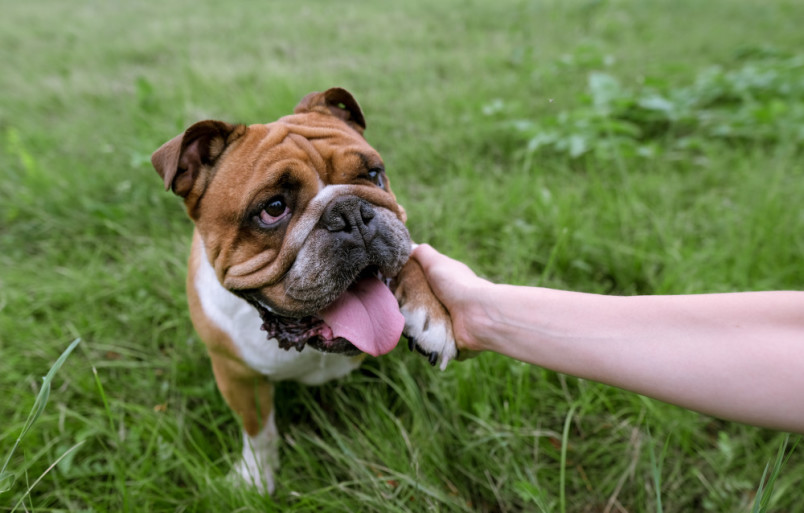
They charm us with their loyalty, friendliness, and iconic scrunched-up faces, but the endearing snores and snorts are often the result of one of many potentially serious health issues that the English Bulldog may face. Familiarizing yourself with common English Bulldog health issues before bringing one into your home will empower you to offer the best possible care.
History and Selective Breeding of English Bulldogs
The name “bulldog” comes from the breed’s original job-they fought bulls in a sport called bullbaiting. This required a dog that was tough, quick, and courageous. When the sport fell out of favor, Bulldogs were left with a sour reputation as fierce fighters, and the breed almost went extinct.
However, as dog shows started to gain popularity, Bulldogs were selected for gentler temperaments. Eventually, a breeder’s club was formed to establish a breed standard and prevent crossbreeding to preserve the Bulldog’s unique traits. While selective breeding preserved their iconic features, it also inadvertently locked in a legacy of English Bulldog health problems.
Breathing Problems in English Bulldogs
Owning an English Bulldog means embracing their quirks, but also understanding their potential health challenges. One of the most important things to be aware of is their vulnerability to respiratory problems. Keep an eye out for these signs, and don't hesitate to consult your vet if you notice any changes in your furry friend's breathing:
Snorts, snores, and wheezes
Gagging
Difficult or labored breathing
Exercise intolerance
Bluish gums
Collapse
Ignoring these warning signs can significantly impair your bulldog's quality of life and happiness. Early detection and intervention are crucial for ensuring your four-legged friend can breathe easy and enjoy every adventure life has to offer.

English Bulldogs and Brachycephalic Obstructive Airway Syndrome
All of that selective breeding to create a pup with a short, smooshed face came at a cost. It made it so many English Bulldogs now have difficulty breathing simply due to their facial anatomy. This makes one of the most common problems with Bulldogs brachycephalic obstructive airway syndrome, or BOAS.
What is BOAS?
A dog with BOAS has one or more structural abnormalities that contribute to breathing difficulty.
Stenotic nares: Nostrils that are too small and often collapse when a dog breathes in.
Elongated soft palate: The end of the roof of the mouth extends into the throat.
Everted laryngeal saccules: Extra folds of tissue in the throat can block the airway when a dog inhales.
Hypoplastic trachea: A windpipe that is smaller diameter than normal.
Every snort and wheeze can be a sign of a hidden battle for every breath. Brachycephalic dogs, including Bulldogs, face a challenging range of symptoms, from mild discomfort to life-threatening breathing difficulties.
Management and Prevention Strategies
BOAS can't be cured, and it can dramatically impact a Bulldog's quality of life. Fortunately, management options exist, tailored to the case's severity. Mild cases may be able to be managed by maintaining a proper weight, restricting exercise to less strenuous options, using a harness instead of a collar, and by preventing overheating. Anti-inflammatory medications and bronchodilators may be helpful as well.
More severe cases may require surgery to help alleviate the symptoms. This by no means cures the issues but can make a difference in how well a Bulldog breathes and how well they can enjoy life. BOAS surgery costs can be extensive, so be sure you’re ready to handle this potential financial burden.
Overheating in English Bulldogs
Since a dog’s main way of cooling down is by panting, anything that impedes airflow can cause a dog to dangerously overheat. Prolonged high temperatures can lead to heatstroke which can result in permanent damage to organs and other body tissues.
Signs of Overheating
Heavy panting
Drooling
Vomiting
Weakness
Confusion
Collapse
Prevention and Treatment
Given their compromised ability to regulate temperature, Bulldogs require extra vigilance in hot weather. This means providing them with a cool place to go when temperatures rise and making sure they have plenty of water available. Keep exercise and playtimes to the cooler hours of the day as well.
If your Bulldog gets too hot, seek a cool spot at once. Offer them some water and help them calm down. If your pup can’t seem to catch their breath or is getting overly hot, place cool, wet towels on their body and get them to a vet immediately.

Skin Issues in English Bulldogs
While respiratory challenges pose a significant concern, the English Bulldog health challenges extend beyond their airways. Unfortunately, another endearing feature of English Bulldogs can also be problematic: their loose, wrinkly skin.
Skin Infections
Those skin folds may make an English Bulldog look like an eternal puppy, but they can also be breeding grounds for infections. Moisture can become trapped in the skin folds, creating a perfect environment for bacteria and yeast to grow. Skin infections can commonly show up in the face wrinkles, tail fold, feet and armpit areas of English Bulldogs. These infections often become inflamed, forming painful red patches called hot spots that can ooze, crust, and cause significant discomfort.
Allergies
While English Bulldog health issues often focus on breathing and skin folds, allergies can add another layer of discomfort to their lives. Environmental triggers and food sensitivities can manifest in itchy rashes, dry, flaky skin, and even chronic ear infections.
Care and Prevention of Skin Issues in English Bulldogs
Speak to your veterinarian if your pup has any issues with their skin. They may recommend specialized cleansers and wipes for the folds, medicated baths for infection control, and tailored dietary adjustments or medication like anti-inflammatories or antihistamines to tackle allergies. In severe cases, additional treatments might be necessary.
Bone and Joint Disease in English Bulldogs
On to other endearing traits that also contribute to Bulldog health problems: their short, bowed legs and their impossibility short tail.
Chondrodysplasia
Chondrodysplasia itself isn’t a disease but rather a disorder. It’s the abnormal development of cartilage that leads to short, angled legs. Some Bulldogs won’t suffer from any problems because of their chondrodysplasia, but others might. As you can imagine, having legs angled differently puts a certain strain on a Bulldog’s bone and connective tissues.
Hemivertebrae
That little corkscrew tail that you’re probably obsessed with may be the result of another bony abnormality called hemivertebrae. Besides a tiny tail, dogs may suffer from hindleg weakness and incontinence.
Others English Bulldog Issues
Before bringing that Bulldog home, you’ll want to be sure they’re screened for hip dysplasia and patellar issues. Arthritis may develop later on, so it’s important that you’re aware of any orthopedic issues that your English Bulldog has or may develop.
Maintaining a healthy weight and having regular veterinary care is an important part of keeping your Bulldog healthy and mobile.
Vision Problems in English Bulldogs
It may start to seem like there isn’t a part of the English Bulldog that isn’t prone to health issues. Well, here’s one that shouldn’t be ignored—those puppy dog eyes. A Bulldog’s eye sockets may be shallower, causing the eyeball to protrude. This sets them up for injuries to the cornea, dry eye and even prolapse of eyeball. All of these conditions can be very serious, so be sure to have your veterinarian check your English Bulldog’s eyes on a regular basis.
Cherry eye is another potential issue that your Bulldog may face. It happens when the tear gland in the inner corner of the eye pops out. It’s often an angry red color. While it may look alarming, cherry eye is usually easily treated by your vet.

Other English Bulldog Health Issues
This may already be a tad overwhelming, but here’s a few more to round out the list of English Bulldog health issues.
Head Shakes
This condition should provide a little good news, it’s generally not a problem. What you’ll see is a Bulldog’s head shaking or head tremors. There is no known cause, and it’s usually not painful. Most of the time the tremors stop when you change their attention to something else. However, if you’re concerned about any abnormal movements in your Bulldog, speak to your vet.
Pulmonic Stenosis
Here’s another for the list--Bulldogs can also be prone to pulmonic stenosis brought on by a hereditary abnormality of the pulmonic valve in the heart. It results in a narrowing that makes it difficult for the heart to pump blood into lungs. If mild, pulmonic stenosis won’t need treatment, while more severe cases may require lifelong medication or surgery. Keep an eye on your Bulldog's stamina during playtime or walks. Watch for signs like excessive panting, reluctance to play, or needing longer rest breaks, as these could be signals of difficulty pumping blood.
Cancer
Sadly, a list of health conditions in dogs wouldn’t be complete without cancer. Bulldogs are especially prone to lymphoma and mast cell tumors. This makes it extremely important to see your veterinarian for any lumps and bumps that may pop up on your dog’s skin. Cancer is best treated when caught early, so regular veterinary visits may help detect cancer when treatment is most effective.
Health Management and Early Detection
We’ve covered quite a few facts about English Bulldogs and the health conditions associated with their breeding. The most important takeaway is how important preventative care is for English Bulldogs. While preventative care can’t completely ensure your Bulldog’s health, it can help decrease the severity of any issues that show up.
Preventative care should involve your veterinarian. Regular checkups are key to catching diseases early on, so you can provide the most effective treatment.
It can be overwhelming to learn about the potential health challenges our beloved Bulldogs face. Those adorable wrinkles, the playful snorts, the goofy waddle – their awesomeness is undeniable! But alongside that joy comes a responsibility to their well-being, and let's be honest, the list of potential health hurdles can feel daunting.
But here's the good news: you don't have to face it alone! Part of a good preventative health program is purchasing dog insurance. Embrace pet insurance is here to walk alongside you every step of the way. Whether it's managing chronic skin issues, alleviating the stress of breathing struggles, or even supporting long-term treatment for a heart condition, Embrace is your partner in protecting your pup’s health and your financial security.
While English Bulldog insurance isn't preventative in itself, getting a policy early is crucial. Pre-existing conditions are often excluded from coverage, so enrolling your Bulldog before any health issues arise ensures they're protected from day one. Think of it as an investment in their future well-being and your financial security. So, one of your first priorities after bringing an English Bulldog home is looking into dog health insurance.
Even with the Potential Heal Issues, English’s Bulldogs Make Great Pets
The soulful eyes, the playful wrinkles, the contagious snorts – English Bulldogs capture our hearts in a way few others can. While their health journey may be unique, their ability to bring joy and unconditional love is unparalleled. Researching reputable breeders who prioritize health testing or considering the potential for future challenges in a rescue dog empowers you to be a proactive advocate for your furry friend. With a little preparation and a whole lot of love, you can create a bond that transcends any challenge, enriching your life with the boundless joy of an English Bulldog companion.